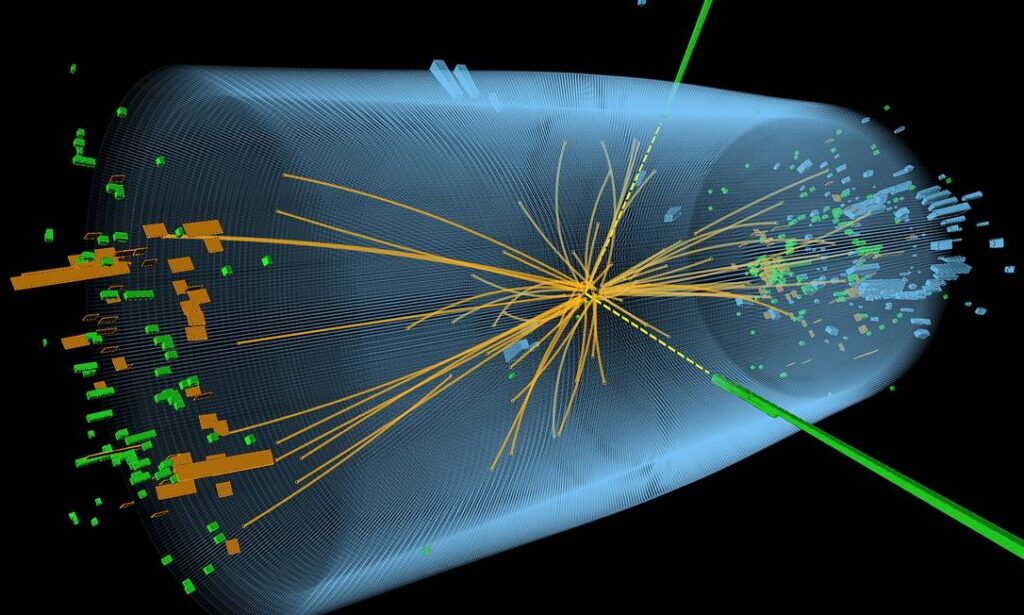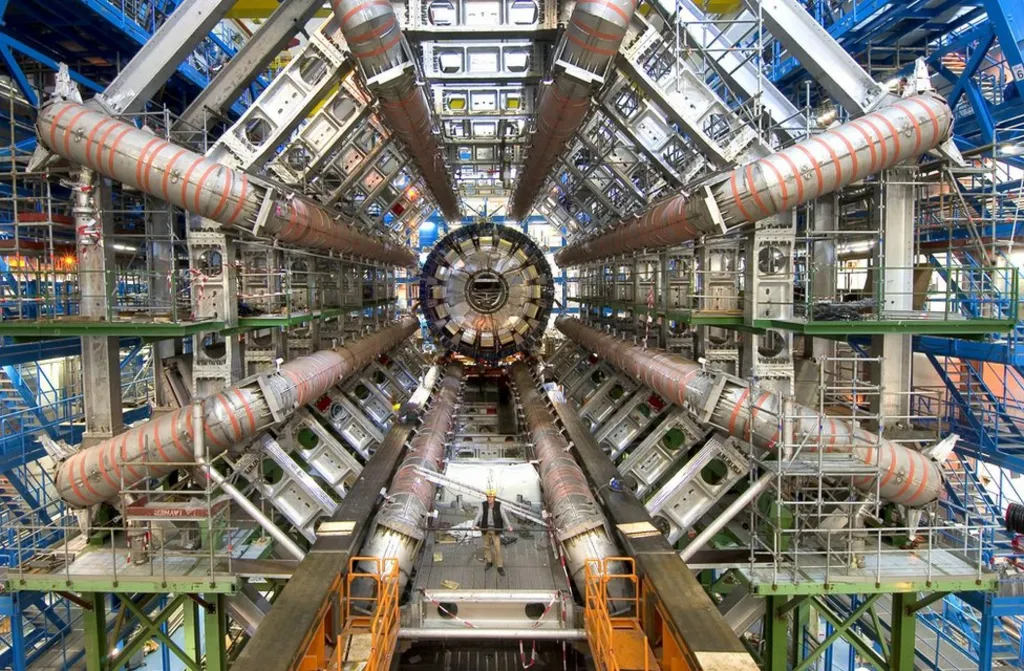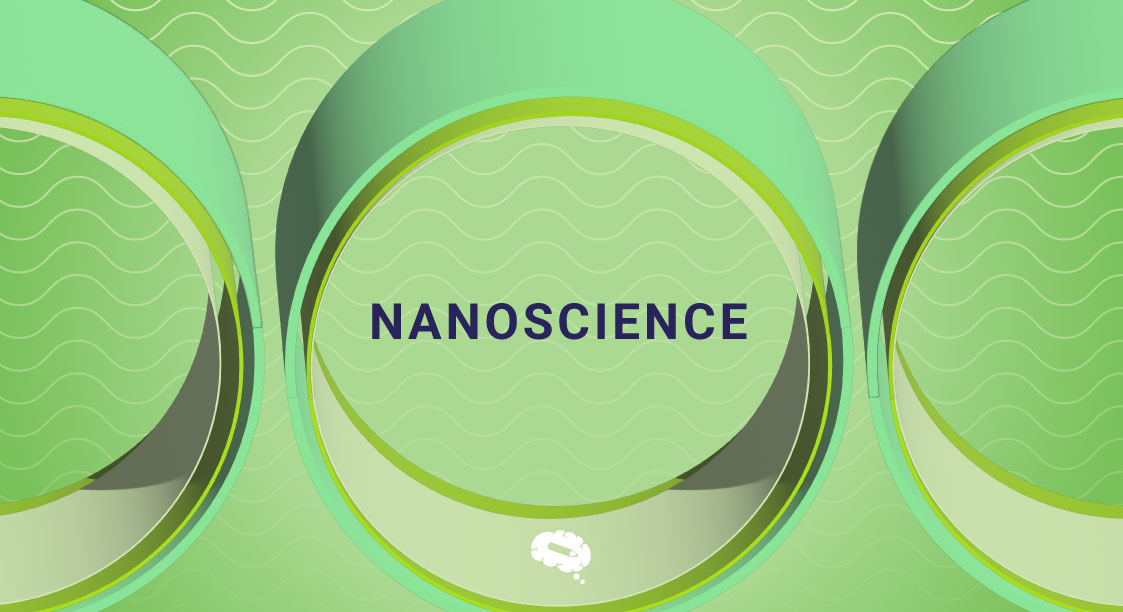Higgs boson particle, also known as the “God particle,” is a fundamental component of the universe that has fascinated physicists for decades. As the particle that gives mass to other elementary particles, it plays a crucial role in our understanding of the fundamental forces of nature. In the 1960s, the Standard Model of particle physics first proposed this elusive particle as part of the universe’s fundamental particles and forces. As we proceed through this blog, we will explore the higgs boson particle a little bit more in-depth!
Hva er Higgs Boson?
Forskerne har i årevis undret seg over eksistensen av Higgs-bosonpartikkelen, siden den er avgjørende for å forklare hvorfor noen partikler har masse, mens andre ikke har det. Universet slik vi kjenner det, ville ikke eksistert uten Higgs-bosonet, som gir masse til partikler som elektroner og kvarker.
Forskere ved CERN (Den europeiske organisasjonen for kjernefysisk forskning) confirmed in 2012 that the Higgs boson exists after nearly five decades of research and billions of dollars in investment. Researchers were able to observe the Higgs boson in action using the Large Hadron Collider (LHC), the world’s largest and most powerful particle accelerator. In addition to validating the Standard Model, this discovery opened up new avenues for exploring the mysteries of the universe. This discovery has also helped to bridge the gap between particle physics and cosmology, providing a better understanding of the universe. In addition, it has enabled researchers to explore the development of new particle accelerators and technologies.

Bildet som CERN har offentliggjort, viser en fremstilling av kollisjonen mellom protoner i eksperimentet for å lete etter Higgs-bosonet Foto: AFP
For å forstå hvordan partikler får masse, må vi forstå Higgs-feltet. Higgs-feltet kan sammenlignes med en tykk, usynlig melasse som sprer seg i hele universet. Ved å vekselvirke med dette feltet bremses partiklene ned, noe som gir dem masse når de beveger seg gjennom det. Higgs-feltet vekselvirker med partiklene på ulike måter, noe som fører til at de får ulik masse. For å kunne bekrefte eksistensen av Higgs-feltet var det avgjørende å oppdage Higgs-bosonet, som er forbundet med forstyrrelser eller eksitasjoner i dette feltet.
Oppdagelsen av Higgs-bosonet
A fascinating story spanning nearly half a century led to the discovery of the Higgs boson. Physics researchers grappled with a significant problem in the early 1960s: how to explain the origin of mass for elementary particles within the Standard Model of particle physics. While the Standard Model successfully described three of the four fundamental forces in the universe-electromagnetism, weak nuclear force, and strong nuclear force-it lacked a mechanism to explain why particles have mass.
Gjennombruddet
As a result of several physicists independently proposing a solution to this problem, a breakthrough was achieved in 1964. These researchers introduced a field that permeates all space, now known as the Higgs field, introduced by Peter Higgs, François Englert, and Robert Brout. They suggest that particles acquire mass through their interaction with this field. As a result of the presence of the Higgs field, a new particle, the Higgs boson, would exist.
There was no proof of the Higgs boson’s existence for decades. An enormous amount of energy was required to produce this elusive particle, making detection a challenge. CERN’s Large Hadron Collider (LHC) was the first facility to allow scientists to directly search for the Higgs boson in the early 21st century.
Viktige forskere involvert
In order for the Higgs boson to be discovered, several key figures played a vital role. The Higgs particle is named after British physicist Peter Higgs. While Higgs’s work built on previous research, he was the first to explicitly predict the existence of a new particle.
Omtrent samtidig med Higgs ble den belgiske fysikeren François Englert og hans kollega Robert Brout independently developed a similar theory. While Brout passed away in 2011, just before the Higgs boson was discovered, Englert and Higgs were jointly awarded the Nobel Prize in Physics in 2013.
The theoretical framework that predicted the Higgs boson was also greatly influenced by Gerald Guralnik, Carl Hagen, og Tom Kibble. Den moderne fysikkens største oppdagelser kan vi takke deres felles innsats for.
Rollen til Large Hadron Collider (Lhc)
The Higgs boson was discovered at the Large Hadron Collider (LHC) at CERN, near Geneva, Switzerland. In high-energy collisions, the LHC accelerates protons to nearly the speed of light, making it the world’s largest and most powerful particle accelerator. In the aftermath of these collisions, scientists are able to probe the nature of matter in conditions similar to those that existed just after the Big Bang.

Atlas detector of CERN’s Large Hadron Collider being constructed in Geneva.
I 2008 ble LHC satt i drift etter flere år med planlegging og bygging. To viktige eksperimenter, ATLAS og CMS, ble utført av forskere fra hele verden for å lete etter Higgs-bosonet og andre partikler. Store detektorer ble brukt til å spore partikler som ble produsert i høyenergikollisjoner i disse eksperimentene.
A new particle consistent with the Higgs boson’s predicted properties was observed by both the ATLAS and CMS experiments on July 4, 2012. Approximately 125 giga-electron volts (GeV) was the mass of the particle, matching the expected Higgs mass range. As a result of this discovery, a critical piece of the Standard Model has been validated, and our understanding of the structure of the universe has been deepened.
The LHC’s success in discovering the Higgs boson was a testament to the collaborative nature of modern science, involving thousands of scientists, engineers, and technicians from all over the world. It marked a new era in particle physics, opening the door to further exploration of the subatomic world and the fundamental forces that govern it.
Konsekvenser av oppdagelsen av Higgs-bosonet
Bekreftelse av fysikkens standardmodell
In physics, the discovery of the Higgs boson was a monumental event, primarily because it confirmed the Standard Model, a theory that has been instrumental in understanding the fundamental particles and forces underlying the universe. According to the Standard Model, the Higgs boson is responsible for the Higgs field, an essential mechanism explaining why certain particles have mass while others don’t.
In this theoretical framework, the Higgs boson was the last missing piece before it was discovered. Experimental evidence for this theory was provided by the detection of the Higgs boson at CERN’s Large Hadron Collider (LHC) in 2012. In testing theoretical predictions with cutting-edge technology, this was not just a triumph for the Standard Model, but also for the broader scientific method.
Impact on Our Understanding of the Universe’s Fundamental Structure
Our understanding of the universe’s fundamental structure is profoundly affected by the Higgs boson’s existence. The Higgs field permeates all of space and interacts with elementary particles like quarks and leptons to give them mass. We would not be able to have matter as we know it without this field.
We have also gained a deeper understanding of the early universe, particularly the aftermath of the Big Bang, as a result of this discovery. It is believed that the Higgs field “switched on” during the universe’s infancy, leading to the formation of mass-bearing particles that led to the development of galaxies, stars, planets, and ultimately life. Thus, understanding the Higgs boson provides critical insights into the structure of the universe.
Mulige implikasjoner for fremtidig forskning og teknologi
I tillegg til å bekrefte det fysikerne allerede mistenkte, åpnet Higgs-bosonet også opp for nye forskningsretninger. Fysikk utenfor standardmodellen har betydelige implikasjoner. Selv om standardmodellen er svært vellykket, gjør den ikke rede for gravitasjon, mørk materie eller mørk energi, som utgjør det meste av universet. Disse mysteriene kan kanskje løses av Higgs-bosonet.
Dark matter may interact with the Higgs field, offering clues to its nature, according to some theories. Furthermore, studying the Higgs boson in greater detail might reveal new particles or forces, leading to a more comprehensive understanding of the universe.
As a result of the discovery, technological advances have already been made in data processing, materials science, and quantum computing. Technology developed for the LHC can be applied to other areas of science and engineering beyond particle physics.
Utfordringer og kontroverser
Utfordringer i arbeidet med å oppdage
Modern physics has been challenged and ambitious by the discovery of the Higgs boson. There was a major problem due to the incredibly elusive nature of the Higgs boson, which has a short lifespan and is very rare. It required enormous energy levels to recreate the conditions of the early universe in order to detect it. CERN’s LHC, the world’s largest and most powerful particle accelerator, achieved this by smashing protons together at almost the speed of light.
It was also challenging to analyze such a large amount of data. In the LHC, protons collide trillions of times per second, most of which are background noise rather than evidence of the Higgs boson. A sophisticated detector, a huge amount of computing power, and advanced algorithms were needed to identify the Higgs boson’s specific signatures among this vast amount of data.
Kontroverser og debatter i det vitenskapelige miljøet
In the scientific community, the discovery of the Higgs boson was not without controversy and debate. Various opinions existed about whether the particle even existed before it was discovered. A number of physicists have questioned the Standard Model’s reliance on the Higgs boson, suggesting alternative theories to explain particle mass.
Selv etter at Higgs-bosonet ble oppdaget i 2012, var det fortsatt en viss skepsis. Noen kritikere mente at det som ble observert, kanskje ikke var Higgs-bosonet slik standardmodellen forutså, men i stedet en annen partikkel eller en variant av denne. Den pågående debatten illustrerer kompleksiteten i partikkelfysikken og den forsiktige vitenskapelige konsensusen, der nye oppdagelser ofte reiser flere spørsmål enn svar.
Kostnader og omfang av eksperimenter
One of the most significant scientific projects in history, the Large Hadron Collider, enabled the discovery of the Higgs boson. Despite this, both admiration and criticism have been expressed regarding the scale and cost of the LHC. It took nearly a decade for more than 10,000 scientists and engineers from over 100 countries to build the LHC. Estimates range from $4.75 billion to $9 billion for the LHC’s financial costs.
Taking into account the urgency of global issues, many critics have questioned the necessity of making such a large investment in fundamental research. Others argue that the money would have been better spent on more urgent concerns, such as healthcare or climate change. In contrast, proponents of the LHC and similar projects argue that fundamental research drives technological innovation and knowledge, often leading to unforeseen practical applications that benefit society in the long term.
Oppdagelsen av Higgs-bosonet er en monumental bragd, men den er også en påminnelse om at jakten på kunnskap, så vel som praktiske hensyn til ressursfordeling, krever en hårfin balanse. Store vitenskapelige gjennombrudd ledsages ofte av debatter og utfordringer knyttet til Higgs-bosonet.
Nåværende og fremtidig forskning
Pågående forskning knyttet til Higgs-bosonet
Researchers have been focused on understanding the Higgs boson’s properties since its discovery in 2012. Higgs boson mass, spin, and interaction strengths with other particles are of particular interest to physicists. There is a great deal of importance to these measurements since any deviation from the predicted values could indicate the existence of new physics.
I tillegg studerer forskerne hvordan Higgs-bosonet henfaller til fotoner, W- og Z-bosoner, samt enda mer eksotiske partikler som kandidater til mørk materie. Det kan være mulig å bruke disse henfallskanalene til å avdekke sammenhenger mellom Higgs-feltet og andre fundamentale krefter i universet. De kan også gi innsikt i Higgs-bosonets rolle i universet.
Hva forskerne håper å finne ut heretter
Oppdagelsen av Higgs-bosonet var en viktig milepæl, men det ble også reist mange spørsmål. Et sentralt spørsmål er om Higgs-bosonet eksisterer som en enkeltstående partikkel eller som medlem av en større familie av Higgs-lignende partikler. Det finnes teorier som antyder at det kan finnes flere Higgs-bosoner, noe som kan forklare den mørke materien og ubalansen mellom materie og antimaterie i universet.
Fysikerne er også ivrige etter å oppdage fysikk utenfor standardmodellen. Selv om standardmodellen har vært svært vellykket når det gjelder å beskrive fundamentale partikler og krefter, forklarer den ikke fenomener som gravitasjon eller mørk energi. Ved å studere Higgs-bosonet med større presisjon kan man utvikle en mer komplett teori om universet.
Nye eksperimenter og oppgraderinger av Large Hadron Collider
LHC ved CERN har gjennomgått en betydelig oppgradering for å kunne utforske Higgs-bosonet og dets implikasjoner ytterligere. For å kunne håndtere partikkelstrålene bedre og forberede seg på fremtidige operasjoner med høy lysstyrke, har 16 nye kollimatorer blitt installert. Denne oppgraderingen forventes å gi mer nøyaktige målinger av Higgs-bosonet og dets egenskaper, noe som vil gi verdifull innsikt i universet.
Med en kollisjonsenergi på 13,6 billioner elektronvolt (TeV) kan LHC nå produsere tyngre og potensielt ukjente partikler. Som forberedelse til HL-LHC-prosjektet ble det installert kryogeniske enheter samt ekstra måleutstyr for varmebelastning. HL-LHC vil inneholde et kompakt superledende krabbehulrom og en akseleratormagnet av niob-tinn (Nb3Sn).
Ved å oppgradere LHC vil datainnsamlingskapasiteten økes, påliteligheten forbedres, og nye oppdagelser innen partikkelfysikk vil bli mulig. Det er mye å se frem til i verdenen av høyenergifysikk i nær fremtid!
In addition to the LHC, other experiments, such as the Compact Linear Collider (CLIC) and the International Linear Collider (ILC), aim to provide a different collision environment (electron-positron collisions instead of proton-proton collisions). A cleaner measurement of the Higgs boson particle’s properties could be achieved with these experiments, opening up new research avenues.
It wasn’t the end of the story when the Higgs boson particle was discovered. In the future, we will be able to gain a deeper understanding of this elusive particle and its role in the universe as research continues. Researchers are exploring the Higgs boson to uncover new physics that could reshape our understanding of the fundamental forces governing the universe. The future of Higgs boson research looks bright and promising with advanced experiments like the HL-LHC and potential new colliders on the horizon.
Kreasjonene dine er klare i løpet av minutter!
Engasjer publikum med visuelt tiltalende bilder som er utviklet på grunnlag av forskningen din, slik at du sparer tid og fanger oppmerksomheten deres. Enten det dreier seg om intrikate datasett eller komplekse konsepter, Mind the Graph gir deg muligheten til å lage engasjerende infografikk. Med vår intuitive plattform kan du raskt lage flotte bilder som kommuniserer ideene dine på en effektiv måte. Vårt team av eksperter er tilgjengelig for å gi deg støtte og veiledning om nødvendig. Begynn å skape i dag, og gjør et varig inntrykk. Besøk vår nettsted for mer informasjon.

Abonner på nyhetsbrevet vårt
Eksklusivt innhold av høy kvalitet om effektiv visuell
kommunikasjon innen vitenskap.





